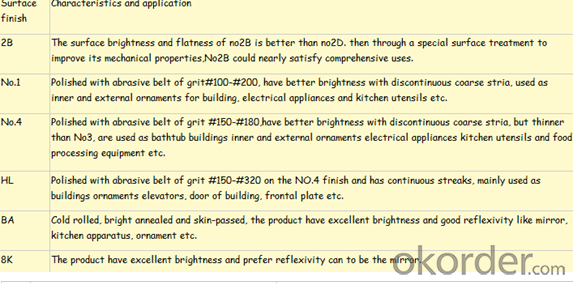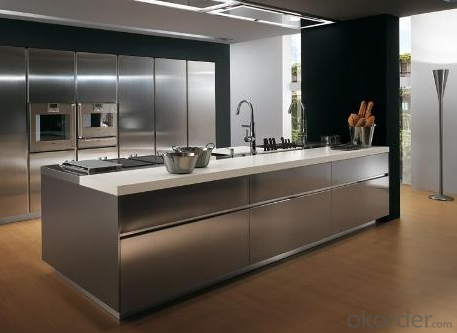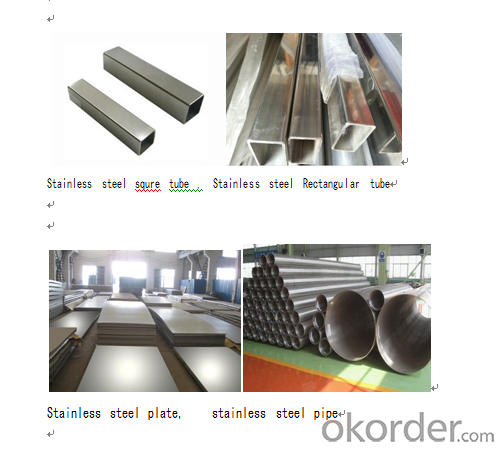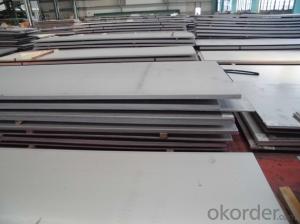CNBM 304/316/430/201 stainless steel sheet/plate with best price
- Loading Port:
- Shanghai
- Payment Terms:
- TT OR LC
- Min Order Qty:
- 10 m.t.
- Supply Capability:
- 1000 m.t./month
OKorder Service Pledge
OKorder Financial Service
You Might Also Like
1,the description of the 304/316/430/201 stainless steel sheet/plate with best price


2,Stainless steel maintenance:
(1) Regular cleaning and maintenance
(2) Pay attention to prevent the occurrence of the phenomenon of surface scratches
(3) Use soap, weak detergent or warm water to remove surface dust, dirt
(4) In addition to the surface of the binder with alcohol or an organic solvent (ether, benzene)
(5) Use neutral detergent or ammonia solution in addition to surface oil
(6) With 10% nitric acid or abrasive detergent in addition to the surface of the embroider caused by the dirt.
3, related peoducts show

4,Speciality and advantages:
1. Our company has been dedicated to producing stainless steel seamless pipe since 2003, owning complete producing technology and abundant managing experience.
2. The raw material such as mother tube, round bar we use is from Chinese biggest and well-known steel mill: Walsin Steel and Yongxing Steel.
3. We have advanced NDT equipments for the tests such as Eddy Current test, Ultrasonic test, Hydraulic test and so on.
4. We have ISO 9001 and PED certificate, and the Third Party Inspection Certificates such as TUV, BV, Lloyd’s, SGS, etc, also can be provided according to customers’ requirements,
5. Wooden case package which is strong and suitable for sea transportation is our main method to pack the pipes. And the economical packing method such as packed in bundles is also welcomed by some customers.
6. The tolerance control we use is D4/T4 (+/-0.1mm) on both inside and outside Diameter and Wall Thickness, which is much higher than international standard ASTM, DIN.
7. The surface condition is one of our main advantages: in order to meet different requirements for surface condition, we have annealing and pickling surface, bright annealing surface, OD polished surface, OD & ID polished surface etc.
5,FAQ
1. Q: What are your advantageous Products?
A: We specialized in 400 series cold rolled stainless steel coils and plates. Our main products are 430, 410S and 409L.
We also supply stainless steel strips and strips in coil as requested.
2. Q: Can you make DDQ ( Deep Drawing Quality)?
A: Yes, we can. Our material can be used for stainless steel pots, stainless steel sinks, stainless steel bowls etc. U can tell us your usage, and we will adjust the mechanical propertise to meet your requirement.
3. Q: What is the application of 400 series stainless steel?
A: 410S stainless steel and 430 stainless steel are widely used for: kitchenware, tableware, cutleries, stainless steel pots, plates & bowls, sinks, gas stove, disinfection cabinet, household appliances, construction decorations etc. 409L stainless steel is usually used for exhaust pipe.
- Q:How do steel sheets perform in terms of electrical resistance?
- Steel sheets are generally poor conductors of electricity due to their high electrical resistance.
- Q:Are the steel sheets suitable for electrical applications?
- Yes, steel sheets are suitable for electrical applications. Steel is a good conductor of electricity, which makes it an ideal material for various electrical components and applications. It can be used for electrical enclosures, panels, cabinets, and other infrastructure where electrical equipment is housed. Steel sheets are also commonly used for grounding systems, electrical connectors, and electrical appliances. Additionally, steel sheets can provide durability and protection against environmental factors, such as corrosion or fire, which are important considerations in electrical applications.
- Q:Can steel sheets be laminated with other materials?
- Yes, steel sheets can be laminated with other materials. Lamination is a process of bonding two or more materials together to create a composite material with enhanced properties. In the case of steel sheets, they can be laminated with other materials such as plastics, polymers, wood, or even other metals. This process is commonly used to improve the strength, durability, corrosion resistance, or aesthetic appearance of steel sheets. Laminated steel sheets can be found in various industries, including automotive, construction, aerospace, and furniture manufacturing.
- Q:What are the safety precautions when handling steel sheets?
- When handling steel sheets, there are several safety precautions that should be followed to ensure the well-being of individuals and prevent accidents. These precautions include the following: 1. Personal Protective Equipment (PPE): It is essential to wear the appropriate PPE when handling steel sheets. This typically includes safety goggles or glasses, gloves, and steel-toed boots. PPE helps protect against potential injuries such as cuts, burns, and eye damage. 2. Proper Lifting Techniques: Steel sheets can be heavy and awkward to handle, so it is crucial to use proper lifting techniques to avoid strain or injury. Lift with your legs, not your back, and use team lifting when necessary. Avoid any sudden or jerky movements while handling the sheets. 3. Secure Storage and Transport: When storing or transporting steel sheets, ensure that they are properly secured to prevent them from shifting or falling. Use appropriate equipment such as straps or chains to secure the sheets, and make sure they are evenly distributed to maintain balance. 4. Clear Work Area: Before handling steel sheets, ensure that the work area is clear of any obstacles or debris. This will help prevent tripping or slipping hazards and provide a clear path for moving the sheets. 5. Adequate Lighting: Proper lighting is essential to ensure good visibility when handling steel sheets. Insufficient lighting can increase the risk of accidents and injuries, so make sure the work area is well-lit to avoid any potential mishaps. 6. Training and Education: It is important for individuals handling steel sheets to receive proper training and education on safe handling procedures. This includes understanding the weight and dimensions of the sheets, as well as the correct techniques for lifting and moving them. 7. Awareness of Sharp Edges: Steel sheets often have sharp edges, which can cause cuts or lacerations. Always handle the sheets with caution and be aware of any sharp edges. If necessary, use protective guards or edge protectors to minimize the risk of injury. 8. Regular Maintenance and Inspection: Regularly inspect the steel sheets for any signs of damage, such as sharp edges, rust, or structural weaknesses. Replace or repair any damaged sheets to ensure safe handling. By following these safety precautions, individuals can minimize the risk of accidents and injuries when handling steel sheets. It is important to prioritize safety and take the necessary steps to protect oneself and others in the work environment.
- Q:What is the average bending radius for steel sheets?
- The average bending radius for steel sheets varies depending on the thickness, grade, and type of steel being used. However, on average, the minimum bending radius for mild steel sheets is generally around four times the sheet thickness. For example, if the sheet thickness is 1.6mm, the minimum bending radius would be approximately 6.4mm. It is important to note that this is a general guideline, and specific bending requirements may differ based on the specific application and desired outcome.
- Q:What is the difference between a perforated and woven steel sheet?
- A perforated steel sheet is a metal sheet that has holes or perforations evenly distributed across its surface. These holes can be of various shapes and sizes, such as round, square, or slotted. Perforated steel sheets are commonly used in applications where airflow, visibility, or drainage is required, such as in architectural design, filtration systems, and acoustic panels. The main advantage of perforated steel sheets is their ability to provide these functionalities while still maintaining structural integrity. On the other hand, a woven steel sheet is a metal sheet that is made by interlacing steel wires together in a specific pattern. This interlacing creates a mesh-like structure, where the wires form a series of intersecting horizontal and vertical lines. Woven steel sheets are commonly used in applications that require strength, durability, and security, such as in fencing, guarding, and industrial filtration systems. The main advantage of woven steel sheets is their ability to provide a high level of strength and security due to the tightly interwoven wires. In summary, the main difference between a perforated and woven steel sheet lies in their respective structures and functionalities. Perforated steel sheets have evenly distributed holes across their surface, providing benefits such as airflow and visibility. Woven steel sheets, on the other hand, are made by interlacing steel wires together to form a mesh-like structure, providing benefits such as strength and security. The choice between the two depends on the specific requirements of the application at hand.
- Q:Are the steel sheets suitable for welding or fabrication purposes?
- Yes, the steel sheets are suitable for welding or fabrication purposes.
- Q:Are the steel sheets suitable for agricultural applications?
- Yes, steel sheets are suitable for agricultural applications. Steel is a versatile and durable material that can withstand harsh weather conditions and provide long-term structural support. Steel sheets can be used in various agricultural applications such as constructing farm buildings, barns, sheds, and storage facilities. They can also be used for fencing, roofing, and siding purposes. Steel sheets offer excellent strength and resistance to pests, fire, and rot, making them ideal for protecting agricultural equipment and crops. Additionally, steel is recyclable, which makes it an environmentally-friendly choice for sustainable farming practices. Overall, steel sheets are a reliable and cost-effective solution for various agricultural applications.
- Q:What is the difference between a brushed and polished steel sheet?
- The surface finishes of a brushed steel sheet and a polished steel sheet vary. A brushed steel sheet is distinguished by parallel lines or scratches on its surface, which are created using abrasive materials or tools. The purpose of brushing is to give the steel sheet a textured look, which helps conceal fingerprints, scratches, and signs of wear. Additionally, it provides an industrial and matte finish. On the contrary, a polished steel sheet boasts a sleek and glossy surface. Polishing involves the use of polishing compounds or abrasive materials to eliminate imperfections, scratches, and oxidation from the steel surface. This process results in a reflective and mirror-like finish, which enhances the visual appeal of the steel sheet. Polished steel sheets are often utilized in applications where appearance and visual attractiveness hold significance, such as architectural design, interior decoration, and high-end products. To summarize, the primary distinction between a brushed and polished steel sheet lies in their surface finishes. Brushed steel sheets possess a textured and matte appearance, whereas polished steel sheets exhibit a smooth and glossy, mirror-like finish. The choice between the two is contingent upon the desired aesthetic, functional requirements, and intended application of the steel sheet.
- Q:What are the safety considerations when working with steel sheets?
- When working with steel sheets, there are several important safety considerations to keep in mind: 1. Personal Protective Equipment (PPE): It is crucial to wear appropriate PPE to protect yourself from potential hazards. This may include safety glasses or goggles, gloves, steel-toed boots, and a hard hat. 2. Lifting and handling: Steel sheets can be heavy and awkward to handle. Use proper lifting techniques, such as bending your knees and keeping your back straight, or use mechanical lifting equipment like cranes or forklifts. Never attempt to lift a sheet that is too heavy for you alone. 3. Slips, trips, and falls: Steel sheets can create slippery surfaces, especially when wet or oily. Keep work areas clean and free of debris, and use non-slip mats or flooring where appropriate. Be cautious of trip hazards, such as cords or tools, and use caution when moving around the work area. 4. Sharp edges and corners: Steel sheets often have sharp edges and corners that can cause cuts or injuries. Use caution when handling and moving them, and wear gloves to protect your hands. If necessary, use edge protectors or file down any sharp edges to reduce the risk of injuries. 5. Fire hazards: Steel sheets can be flammable when exposed to high temperatures or sparks. Ensure that work areas are clear of flammable materials and follow proper fire safety procedures, such as having fire extinguishers readily available and knowing how to use them. 6. Noise and vibration: Working with steel sheets can generate significant noise and vibration. Wear ear protection, such as earplugs or earmuffs, to protect your hearing. If using power tools, ensure they are properly maintained and have vibration-dampening features to minimize the risk of hand-arm vibration syndrome. 7. Adequate ventilation: Some steel sheets may release fumes or dust when cut or welded. Ensure that the workspace is well-ventilated to prevent the accumulation of harmful gases or particles. If necessary, use exhaust fans or wear respiratory protection to avoid inhalation of hazardous substances. By following these safety considerations, you can minimize the risks associated with working with steel sheets and create a safer work environment for yourself and others.
1. Manufacturer Overview |
|
|---|---|
| Location | |
| Year Established | |
| Annual Output Value | |
| Main Markets | |
| Company Certifications | |
2. Manufacturer Certificates |
|
|---|---|
| a) Certification Name | |
| Range | |
| Reference | |
| Validity Period | |
3. Manufacturer Capability |
|
|---|---|
| a)Trade Capacity | |
| Nearest Port | |
| Export Percentage | |
| No.of Employees in Trade Department | |
| Language Spoken: | |
| b)Factory Information | |
| Factory Size: | |
| No. of Production Lines | |
| Contract Manufacturing | |
| Product Price Range | |
Send your message to us
CNBM 304/316/430/201 stainless steel sheet/plate with best price
- Loading Port:
- Shanghai
- Payment Terms:
- TT OR LC
- Min Order Qty:
- 10 m.t.
- Supply Capability:
- 1000 m.t./month
OKorder Service Pledge
OKorder Financial Service
Similar products
New products
Hot products
Hot Searches
Related keywords




























